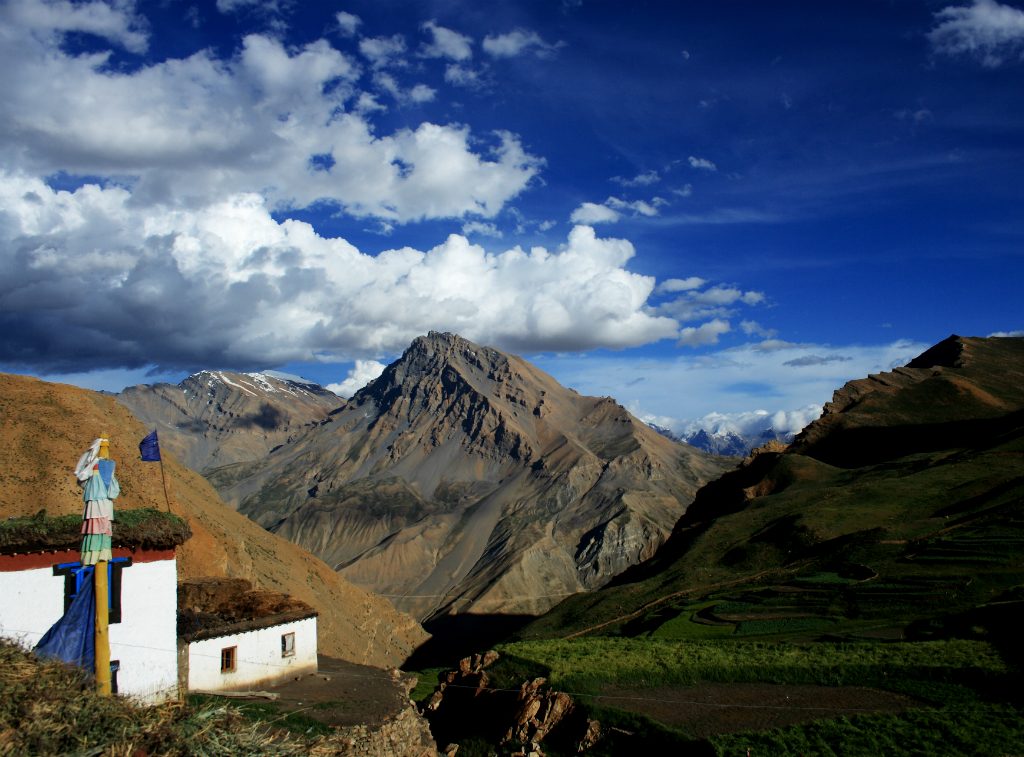You may be planning a trip to Demul, but do you know the story of Demul village in Spiti Valley and how it was found on the map? Well, let’s learn about this little homestay hub of Spiti Valley in the travel guide.
Once upon a time, there was a land, highly fertile and surrounded by tall mountains of the Himalayas, which was undiscovered until a farmer lost his yak and went searching for it. He found his yak grazing on the well-grown green grass in that land. Having found this new meadow for his cattle, he started living there with his family.
He later invited other members of his community to settle down there, grow food, and raise livestock. And that’s how a new village called Demul was born. Keen to visit this remote village in Spiti valley? Read on and find out more about its treasures.
Demul is popular among the hikers who plan the homestay trek from Kibber to Langza to Demul villages via Komic.
Let's quickly dive into the details:
About Demul Village – Spiti Valley
Demul is a village with a little over fifty houses, which is big enough by Spitian standards. It personifies solitude, simplicity, and remoteness in this middle land of Spiti. The village has a very well organized system of homestays in Spiti which ensures equitable and consistent livelihood for all of its residents.
The folklore says it was named after the female yak (Demo) in the story I mentioned above. More than two hundred years old, Demul village is an example of a strong community-based enterprise that supports sustainable tourism and brings sustenance to locals. Flat roofed mud houses and green pastures make up most of the village.

Location
This high altitude village thrives at an altitude of 14,170 feet at a trans-Himalayan valley in the Spiti region. Demul is around 32 kilometers eastward from the town of Kaza.
It forms a part of the high villages belt of Spiti which includes Hikkim, Komik, Langza, Kibber, Tashigang, Gette, and Lhalung.
How to Reach Demul from Kaza
If you are driving from Kaza to Demul, it will take one hr drive to reach this beautiful hamlet. An uphill offshoot of the main road along the Spiti river, just before Lidang village will take you to Demul.
This is a 20 km stretch of tarred road, called Demul road. Another way to drive down to Demul is from Koumic, but the road is a deconstructed dirt track, for most of the way. There is a local bus from Kaza to Demul which leaves at 5:00 pm, and the same bus returns the next morning at 7:30 am from Demul to Kaza.
Demul is connected to all of the high villages of Spiti Valley. Some travelers choose to trek to Demul from Koumic or Hikkim as well on their homestays trek of these high villages.
What is the Best Time to Visit Demul
June, July, and September are the best months to visit Demul and nearby villages of Spiti Valley. You will find snow from May to June period nearby Demul, and in September you will find beautiful colors in Spiti Valley.
Spiti season starts in summer and it is a good time for a hassle-free trip to the region. A white blanketed Spiti during winters looks hauntingly beautiful, but poses many challenges to reach there. The road from Manali to Kaza remains closed during winter and you can only travel to Spiti via Kinnaur in winter months.
I am an advocate of choosing your own experience and time to visit any place. That’s why I say, the best time to visit Demul or Spiti valley depends on the kind of experience you are seeking. Every season has its pros and cons. It also depends upon the route you wish to take to Demul between Manali to Kaza or Shimla to Kaza.
Manali to Kaza route is only open from mid-June to October in a year. Hence, it is the only window of time to visit Demul from Manali side if you plan to do so. In winter months, even if you reach Spiti Valley via Kinnaur, the access roads to Demul village remains closed for the entire winter.
For a detailed and month-by-month guide on when to travel to Spiti, please refer to our article ‘Best Time to Visit Spiti Valley – A Month by Month Guide’

What to experience in Demul
Demul is the epitome of remoteness, solitude, and a pace of life which is unusual for city folks. Walking in the Himalayas comes with its perks of seeing the unseen, while the mountain breeze soothes you and you continue to enjoy the raw nature.
Balari Top
This is a hilltop point at the elevation of 16,000 feet, which presents an amazing bird’s eye view of Spiti valley. Balari top is the only place from where you can see eighteen villages spread across the Spiti valley, three meandering rivers (Spiti, Lingti, and Pin), Dhangkar monastery, wind-sculpted rocks and a landscape which is the signature of Spiti. The famous Chao Chao Kang Nilda and Kanamo peaks are also visible from this gem of a point near Demul.
Balari top is three hours of a hike away from Demul village with a gentle gradient but the elevation can be arduous. Hence, it is important to understand the basics of high altitude trekking in the Himalayas.
Live Local Way
Similar to other places in Spiti Valley, the villagers at Demul are welcoming. They let you engage with their lives, work, and families – an experience that stays with you forever. If you like it, then get your hands on the work at farms, kitchen, and the households while your hosts nourish you with local stories about their lives, culture, and folklore.
If it is the season of Chhaang making, you can even get to see the formation of the local barley beer.

Where to Stay & Eat
The highlight of Demul is the well-orchestrated homestay system, which is managed by a coordinator (a resident of the village). The system works like this – you land at Demul and meet the village coordinator who allots you a house to stay.
However, travelers are not allowed to stay at a house for more than one night. Next night, some other household (again allotted) will be your host. Every year, half of the houses in the village participate in hosting travelers. Other half get their turn the subsequent year.
This ensures an equitable distribution of income to every house in the village and a unique experience to travelers. The food at Demul is a blend of Himachali and Tibetan with some local Spitian dishes.
From Paranthas and Pulao to Bread-jam, Momos, Thukpa, and ginger tea, everything tastes comforting and delicious at this altitude. As they say, there is something in the air!
Do not forget to check my list of good hotels or stays in Spiti Valley.

Conclusion
Demul is the hub of homestays in Spiti valley and yet is not frequented on the usual Spiti itinerary. You can experience the Spitian lifestyle in other villages too. However, what sets Demul apart is its democratic system of homestays, the solitude, and not to forget the panoramic view from the Balari top. The joy of going beyond the usual is incomparable, and such is the feeling you get being at Demul.
Demul is a textbook example of sustainable tourism and equitable income. Sustainable tourism includes living local, eating local and helping locals in improving their lives while maintaining the ecological balance of the place.
Have a travel question?? You can subscribe to my YouTube channel and leave a comment to ask your travel questions about traveling to the Himalayas.
It is amazing to see the growing breed of travelers who understand responsible tourism and love to immerse themselves in the local experience. Even a night’s stay at Demul can bring you closer to doing your bit for the local community and, in return, give you memories for life.
I hope, this travel guide to Demul will help you to plan your journey better and make it a memorable one.
Do you still have any questions or suggestions or need any help in planning your trip to Demul? If yes, please feel free to post them either in the comments section of this article below or direct message on Instagram.
If you like the article, please feel free to share it with any of your family or friends who are planning a trip to Demul or Spiti Valley.
Happy traveling to you!!!
Do follow @soulful_worldview on Instagram for updates on my next adventure.
Follow me on Instagram and Ask any questions you might have for me!!





